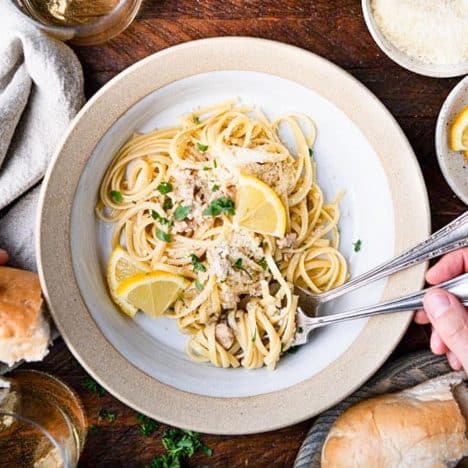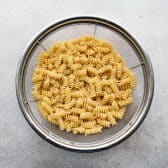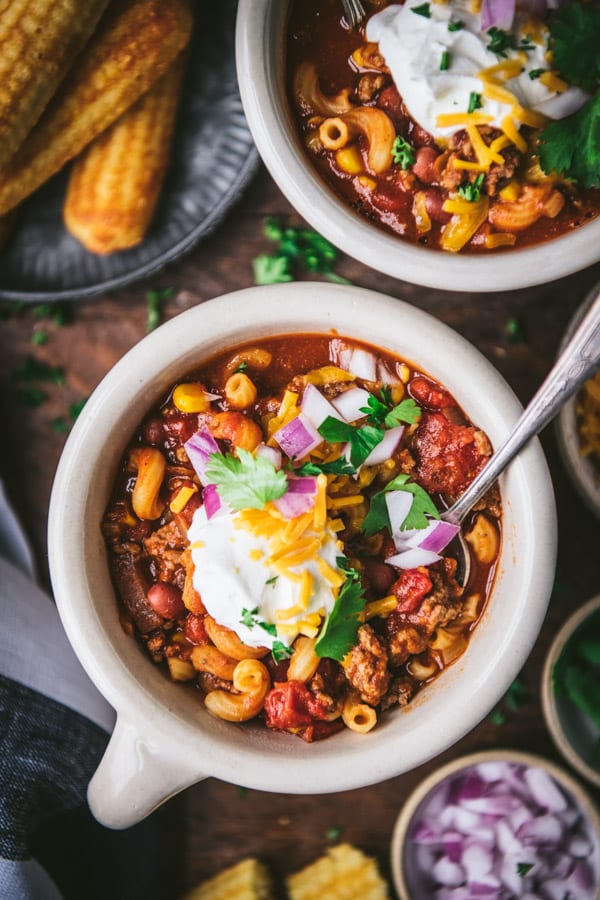Disclosure: This post may contain affiliate links. I may earn a small commission for my endorsement, recommendation, testimonial, and/or link to any products or services from this website.
Pesto pasta combines tender noodles with an easy, no-cook, traditional homemade pesto sauce. Classic ingredients like olive oil, Parmesan, pine nuts, garlic, and fresh basil come together in a simple and flavorful dish that’s ready in just minutes.

Table of Contents
If you love homemade pasta sauce recipes, be sure to try this 5-ingredient pomodoro sauce, a pot of easy bolognese sauce, this creamy tomato pasta sauce, the best spaghetti sauce recipe, and this crockpot spaghetti sauce, too!

Why You’ll Love this Recipe
- Fresh Ingredients. Pesto pasta is such a great summer dish because it takes advantage of the season’s fresh herbs, and you don’t even have to cook the homemade pesto sauce.
- Quick and Easy. If you can boil pasta, then you can make this dish! While the water boils and the noodles cook, blend together the sauce in about 10 minutes.
- Versatile. The homemade pesto sauce is obviously delicious on pasta, but you can also use it in other ways. For instance, drizzle it on fish and other seafood (like grilled salmon or scallops); use it as a swap for tomato sauce on pizza; spread the sauce on focaccia bread and pile it high with Italian meats for the ultimate Italian sandwich; add a dollop to a piece of grilled chicken, or try this dump-and-bake basil pesto chicken. Jazz up veggies with pesto, too! The sauce is a flavorful addition to salad dressings and dips (just stir with mayo and/or sour cream).

Ingredients
This is an overview of the ingredients that you need for an easy pesto pasta recipe. As always, specific measurements and step-by-step instructions are included in the printable recipe box at the bottom of the post.
- Fresh basil: when measuring the fresh basil leaves for this pesto recipe, gently press them down to fill the measuring cup. You don’t want to pack them firmly and tightly, but you do want to press them down a bit. When you release your fingers, they will likely pop up over the top of the cup — that’s fine!
- Parmesan cheese and garlic: for rich, bold flavor.
- Toasted pine nuts: toasting the pine nuts gives the sauce a much deeper flavor. Pine nuts burn easily when toasted in a skillet, however. Instead, I quickly toast my pine nuts in the microwave. Just place the nuts on a microwave-safe plate and cook on high power in 30-second intervals, stirring in between. The nuts will be toasted and fragrant within 1-2 minutes.
- Extra virgin olive oil: emulsifies the sauce and helps it cling to the noodles.
- Kosher salt and ground black pepper: enhance the flavors of the other ingredients.
- Pasta: I’ve shown fusilli pasta here, which we love because the textured surface holds the pesto sauce so well. Similar options include rotini, gemelli, rotelle, cavatappi, and penne pasta. Additionally, spaghetti or linguine are excellent options, allowing the sauce to coat the strands evenly. The best pasta for pesto really comes down to personal preference.
- Butter and reserved pasta cooking water: the butter adds a creamy richness and silky smoothness to the sauce. Starchy pasta cooking water acts as a natural thickener and binder for the sauce. When combined with the butter and pesto, it helps emulsify the ingredients, creating a cohesive sauce that coats the pasta evenly.

Directions
Pesto is a sauce that was invented in Genoa, Italy to take advantage of the superior basil that grows in the Italian Riviera. The sauce is never cooked, and Genoese cooks insist that pesto should be made with a mortar and pestle — after all, the name “pesto” comes from the word pestare, meaning to pound or to grind (as in a mortar).
These days, however, it’s much more common for home cooks in the United States to prepare a traditional pesto sauce with quick help from a food processor. You’ll find detailed directions for this pesto pasta in the recipe card below, but here’s the overview:
- Boil the Pasta. Cook the pasta in a large pot of well salted water according to package directions for al dente. Reserve some of the pasta cooking water, then drain.
- Make the Pesto Sauce. While you wait for the water to boil and the pasta to cook, blend together the homemade basil pesto sauce.
- Toss the Pasta with Sauce. Place the drained pasta in a large bowl. Add the pesto, a pat of butter if you like, and a splash of the pasta cooking water. Stir until the sauce is silky and smooth, adding more pasta water if needed.
- Garnish and Serve. Sprinkle with extra Parmesan, a squeeze of fresh lemon juice, and freshly ground black pepper. Serve immediately.

Serving Suggestions
Serve the pesto pasta with a side of garlic bread or focaccia and a crisp Caesar salad. For added protein, you might like a piece of marinated grilled salmon, crab cakes, grilled steak tips, grilled chicken, or some marinated grilled shrimp.

Preparation and Storage
- How to Store: Use the pesto right away, while it’s at its peak freshness! If you have extra pesto, place in an airtight container with the smallest top surface area. Pack the pesto tightly to eliminate air pockets, and pour a thin layer of olive oil on top. Then press a piece of plastic wrap directly onto the oil before closing the lid. Sealing the sauce off from exposed air helps to prevent the pesto from browning, since the browning occurs due to oxidation (when the cut basil leaves are exposed to air). The homemade pesto will last in the refrigerator for up to 1 week.
- How to Freeze: Pack the pesto as described above. It’s easiest to freeze the pesto in small portions so that you can thaw only what you need for a given meal or recipe. Try using an ice cube tray for individual servings of frozen pesto. The pesto will last in the freezer for up to 6 months.
- Leftover cooked pesto pasta will keep in an airtight container in the fridge for 3-4 days. It will likely dry out a bit as it cools and sits, so freshen it up with a splash of water, a pat of butter, and some extra sauce when reheating. You can reheat individual servings in the microwave for 30-60 seconds, or until warmed through.

Recipe Variations and Tips for Success
- If you don’t have a food processor, use a blender to make homemade pesto.
- The amount of pesto that you use for each pound of pasta is a matter of personal preference. A good rule of thumb is approximately ⅔ cup of pesto for every 1 pound of pasta. This recipe yields about ¾ cup of sauce, which will be enough for about 1 – 1 ½ pounds of pesto pasta. Don’t forget to thin the sauce with cooking water and butter, to taste.
- Swap out the pine nuts and use toasted walnuts or almonds instead.
- Use fresh baby spinach leaves in lieu of the basil leaves. Since spinach doesn’t have nearly the flavor that basil has, I recommend adding at least a few fresh basil leaves (or other fresh herbs) for extra flavor.
- Swap out the basil and use other fresh herbs like parsley.
- Add cherry tomatoes for an extra bright burst of summer flavor, or make it spicy with red pepper flakes.
- Authentic, traditional pesto recipes suggest that you stir the cheese into the sauce at the very end. The cheese is grated, but not processed. As a result, the pesto sauce has a more grainy texture. If you prefer a smoother pesto (like we do), it’s common in the United States to add the cheese to the food processor with the other ingredients.

More Pasta Recipes to Try
Summer Pasta (Dump-and-Bake!)
52 minutes mins
Linguine with Clam Sauce
20 minutes mins
Lemon Chicken Orzo
45 minutes mins

Pesto Pasta with Homemade Pesto Sauce
Ingredients
- 1 lb. pasta (I used fusilli here, but almost any shape will work)
- ¾ cup reserved pasta cooking water (you likely will not need all of this water)
- ½ cup freshly grated Parmesan cheese, plus extra for serving
- 2 tablespoons toasted pine nuts
- 2 cloves garlic, peeled (about 2 teaspoons minced)
- ½ teaspoon kosher salt, plus more to taste
- 2 cups loosely packed fresh basil leaves
- ½ cup extra virgin olive oil (or more as needed to reach desired consistency)
- Ground black pepper, to taste
- 1 tablespoon butter (optional)
Instructions
Cook the Pasta
- Cook the pasta in a large pot of well-salted boiling water according to package directions. Before draining the pasta, reserve about ¾ cup of the starchy pasta cooking water. Drain.
Make the Pesto Sauce
- While you're waiting for the pasta water to boil and waiting for the pasta to cook, prepare the pesto sauce. Place the Parmesan, pine nuts, garlic, and salt in a food processor. Pulse to combine.
- Add the basil to the food processor, and slowly drizzle in the olive oil while pulsing. Process until the sauce comes together in a uniform, creamy consistency, scraping down the sides occasionally and adding extra olive oil, if necessary.
- Taste and season with additional salt and black pepper, if desired.
Toss the Pasta with the Sauce
- Place the hot cooked pasta in a large bowl. Gradually add the pesto sauce (you might not want all of it), about ¼ cup of the pasta water, and the butter (if using). Stir gently to combine, adding a little bit more pasta water, as necessary, until the sauce is silky and smooth. Taste and season with additional salt and pepper, if desired. Garnish with extra Parmesan cheese and serve.
Notes
Nutrition
This recipe was originally published in June, 2020. It was updated in June, 2024.























